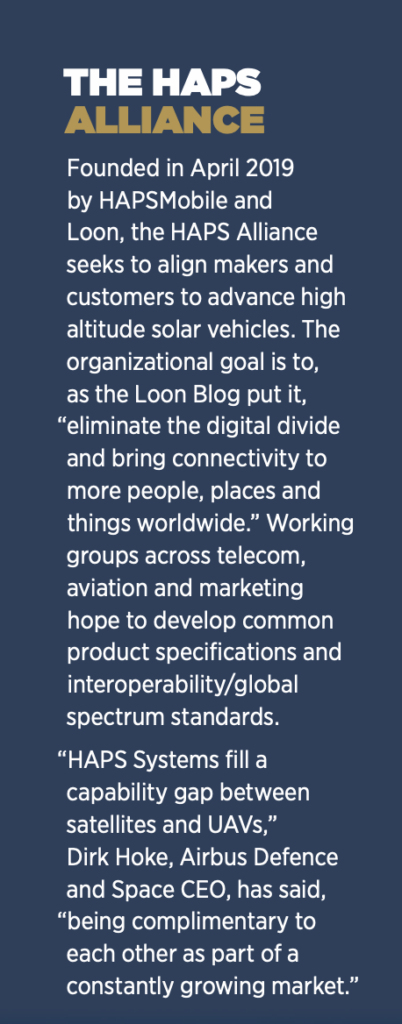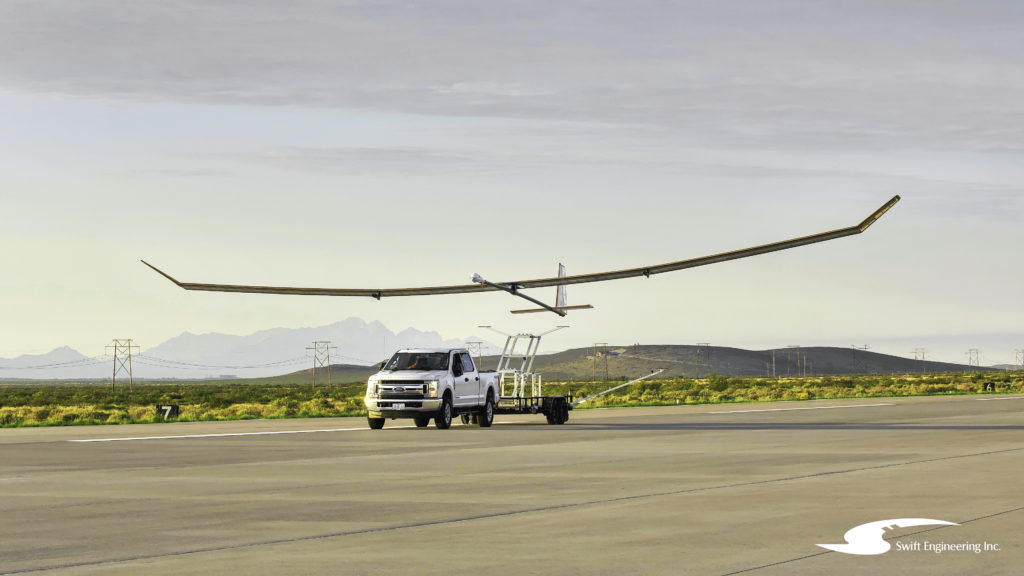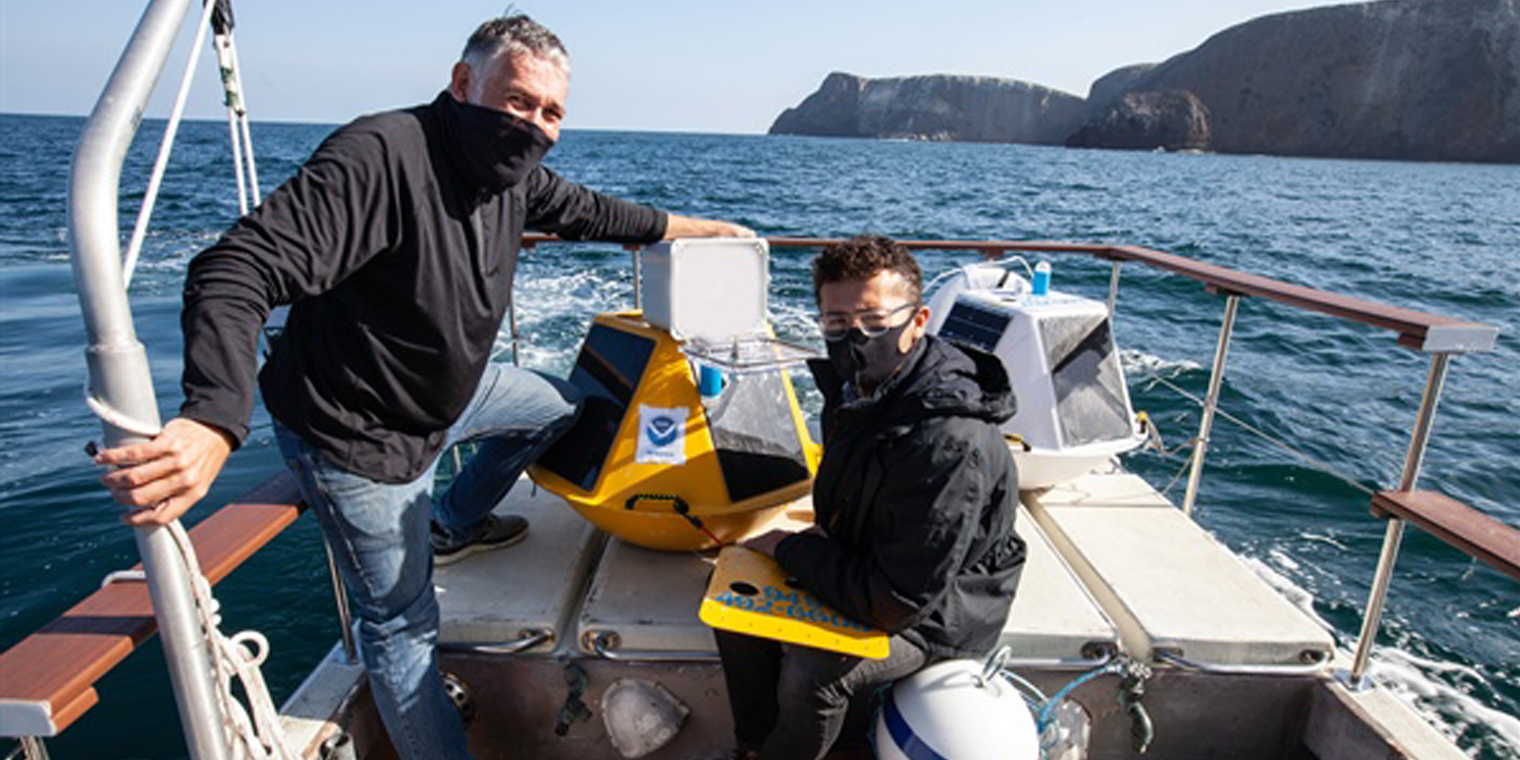Swift Engineering’s SULE takes to the air.
Many years ago, as a young newspaperman, I received a plum assignment to retrace Charles Lindbergh’s trans-Atlantic flight. Rather than shivering in the Spirit of St. Louis monoplane, I flew the Atlantic in the Mach Two comfort of the Concorde. Eating lobster at a near-stratospheric 60,000 feet, I squinted at the curvature of the earth.
The quest to soar toward the sun dates back to mythology. But during 2020, an increasing number of lightweight unmanned vehicles have explored paths toward sustained solar-powered high altitude flight. Known as HAPS and/or HALE (see the “HAPS, HALE or Both?” sidebar on page 20), they soar between 55,000 and 70,000 feet above sea level, above clouds, wind and weather, with less power needed to maintain position. Station keeping above one point, or through footprint-expanding mini-fleets with reinforcing capabilities, they can cover more territory than ground stations and offer greater resolution, decreased latency and much lower costs against satellites. They can be landed and replaced during a single weather window.
“This is harvesting energy from the sun,” said Tom Clancy, CTO of Aurora Flight Sciences/Boeing, developer of Odysseus, which is named for mythology’s epic traveler. “The only thing that limits the endurance is ultimately the life expectancy of the battery.”
Sensing a stratospheric “sweet spot” for telecom and other applications, companies and vehicles from A (Aurora) to Z (Airbus’ Zephyr) are in various stages of “looking down or beaming down,” as Phil Varty, business manager UAV Systems at BAE Systems, put it. From Australia to Belarus, tests and flights are foreshadowing near-future sustained operations, primarily between plus and minus 25 degrees latitude, placing “flying cell phone towers” above developing countries.
On September 21, a “signal” event occurred when HAPSMobile®, a SoftBank subsidiary minority-owned by AeroVironment, flew AeroVironment’s Sunglider® from Spaceport America in New Mexico. The cells across Sunglider’s massive 262-foot wingspan allowed it to spend more than five hours in the stratosphere, while Alphabet’s Loon provided a 15-hour LTE connection, including an air-to-ground videocall to a standard Google Pixel handset. Other fixed-wing craft had flown far longer—Airbus’ Zephyr for a record of nearly 26 days in 2018—or higher—AeroVironment’s own Helios reached close to 97,000 feet in 2001. But at least one celebrant saw transcendent commercial potential. As AeroVironment CEO Wahid Nawabi told Inside Unmanned Systems before the flight, “We believe HAPS will disrupt the multi-billion global telecom cell tower infrastructure business.”
Yet as Aurora’s Clancy cautioned, “basic fact is, there’s never been an operational solar airplane that has served a customer.” The stratosphere is fiercely cold, windy and half-dark. Wings need to be large and strong enough to support arrays of solar cells and rechargeable batteries, thin enough to minimize drag, light enough not to excessively drain power. Battery efficiency remains a work in progress. And customers want “better, faster, cheaper.” Nevertheless, visions of year-long flights, major deployments and corporate collaborations have developers working to fuse technology and business considerations on HAPS/HALE’s celestial field of dreams.

PHASA-35: Tech Meets Business
PHASA-35®, a 115-foot wingspan solar aircraft from Prismatic/BAE, completed its debut flight in February 2020 at the Woomera test range in Australia. The mission capped a 20-month push from design to launch.
“PHASA” stands for Persistent High Altitude Solar Aircraft, “35” references the wingspan in meters. “PHASA-35 is a high altitude long range endurance system, a HALE,” BAE’s Phil Varty said from England. “But it’s also known in the wider market space as a HAPS system—a high-altitude pseudo-satellite operating in the stratosphere.
“We’ve been kind of monitoring this whole area for perhaps 15 years,” Varty continued. “When one or two were beginning to mature at some pace,” BAE acquired Prismatics in 2019. PHASA has applications from surveillance to 5G communications. As Varty put it, “this is a telephone pole with a camera.”
“Aerospace companies in general, have long timelines in watching where the market trends are going,” Varty added. In fact, altitude slar vehicles dates back 50 years. In 1970, the High Platform II, a collaboration between Raven Aerostar and the U.S. Navy, made the first unmanned airship flight under solar power. In 1980, AeroVironment’s Solar Challenger began a multi-decade, multi-company development of the lightweight tubes, spars, membranes and cell-rich wing arrays that could lift unmanned sun-powered aircraft to altitude and offer the battery strength needed for station keeping ket trends are going,” Varty added. In fact, the the modern quest to develop high altitude solar vehicles dates back 50 years. In 1970, the High Platform II, a collaboration between Raven Aerostar and the U.S. Navy, made the first unmanned airship flight under solar power. In 1980, AeroVironment’s Solar Challenger began a multi-decade, multi-company development of the lightweight tubes, spars, membranes and cell-rich wing arrays that could lift unmanned sun-powered aircraft to altitude and offer the battery strength needed for station keeping at night.
Varty and his colleague, Greig Doherty, BAE’s chief engineer, Solar HALE program, took turns explaining the nexus of technical and market considerations.
“It’s not really wing size, it’s what it gives you, which is payload capacity, what sensors you can carry,” Varty explained. “Too small and you can’t carry the majority of things that people are interested in; too big and too complex, then you’re in the Global Hawk category, which is a fortune to buy and difficult to export. Whereas, we’re just up there all of the time, with no maintenance to when we come down, months and months later.
“Having done the analysis of what the sensor market looks like, for cameras, for radar, for other types of sensors, 15 to 25 kilos [33 to 55 pounds] is where we think that sweet spot is. You need that wing area to put the solar panels on. But it starts with, ‘How much do I want to carry?’”
Doherty agreed. “You start with the payload maths. The best wing to generate lift and minimize drag in the stratosphere. The best means of propulsion efficiency—we’re using good old-fashion propellers, highly efficient propellers for where the air is thinner.
“The payload is at the business end of operations. It’s that feature the customers are interested in.”
But customer interest in PHASA-35 will have to wait. Doherty explained: “The February 2020 was a shakedown flight; it didn’t reach an operational altitude by any means.” But, he said, “it gave us the confidence to continue the project. We’ve done an awful lot of flying what we call the PHASA-8™. It’s a quarter-size of the PHASA-35, but it includes many of the systems on the full-scale PHASA-35. There’s no solar array but it’s a really good way of taking some of the risks out of the program.”
This October, a 72-hour, hanger-based “soak test” included “activated payloads. We charged and discharged the battery cycles,” Doherty explained.” Trials continue, some in the U.S. “The U.S. is one of those forward-leaning nations on this sort of thing,” Varty said. “There’s been quite a bit of investment in some of these companies.”
Doherty’s optimism: “I think it is an absolutely fascinating technology.” Varty’s caution: “There are laws of business dynamics as well.”

Odysseus: Voyage Interrupted
“I think we named it Odysseus because it’s been such a long journey.”
Tom Clancy is CTO at Aurora Flight Sciences, developer of the Odysseus large HAPS vehicle. Odysseus’ antecedents include the human-powered, MIT-developed Daedalus, which in 1988 set still-standing world distance and duration records in that category. Carbon fiber tubes, Mylar wing skin, Kevlar fuselage components—“a lot of the same structural optimization principles as the solar airplane flight domain were applied to those human-powered airplanes,” Clancy said.
In 1989, Aurora’s Flight Sciences, now headquartered in Manassas, Virginia, was founded in the proverbial garage to use UAS for atmospheric research. Its SolarEagle was part of DARPA’s Vulture Program, itself a search for a high altitude plane that could join smaller vehicles together at their wingtips to stay aloft for 5 years and deliver ISR (intelligence, surveillance and reconnaissance). In 2012, Vulture retreated to focus only on solar energy technologies, but Boeing had noticed and acquired Aurora in 2017.
Spurred by greater specific energy of batteries and inertial nav miniaturization, Aurora’s current iteration features a very long (243 foot) wing with six propellers, a fiberglass upper skin and plastic film underside, three horizontal and three vertical stabilizers to control roll. The idea is to cover the entire large wing with strung-together solar cells; the details involve how to best maximize cell contribution to energy collection.
“You fly faster than the winds, you get station keep. If you can’t station keep, you get blown downwind.”
Clancy envisions small fleets carrying practical payloads across regional coverage. He agrees with the plus-minus 25 degrees from the equator as where batteries don’t need to work as hard as they might during, say, a high-latitude winter. “Our design is focused on staying above 60,000 feet on the winter solstice.”
The ability to station keep at high altitudes, Clancy agreed, has made telecom “the vision for this technology for many years.” He identified remote sensing and national security as other fits.
“You’re probably not cheaper than the smallest research cube sat,” Clancy granted. ”But these vehicles are substantially cheaper than a geo bird.” Not being 22,000 miles away reduces signal latency, and there’s persistence rather than satellite revisits. “Launching satellites has very long timelines and relatively significant business risk. With a HAPS airplane, you can update payloads much more quickly because you can land it and put it back up there.”
Despite these advantages, Odysseus canceled its first flight in 2019. “The constituent technologies are there today,” he said. But for Aurora, customers and external funding would come first.
“There are many of us, collectively trying to innovate and generate a new market that doesn’t exist yet. What is the right partnership between technologists like us and operational partners is important.
“Fundamentally, there’s the cost curve challenges. Can you get all those technologies together in a reliable package and drive down the cost curve to intersect with the demand? I think there are challenges in the maturation of the integrated system for the whole industry.”

SULE: Reverse Technology Dispersion
San Clemente, California-based Swift Engineering raced into the world of HALE. Founded in 1983 to design and build race cars, its IndyCar won its debut outing. In 2000, Swift entered the aerospace market, becoming known for its blended-wing Killer Bee UAV. In 2014, Swift joined the high altitude world of solar-powered craft.
“There’s so much automotive and aerospace history here, you could develop and mold completely new products and technologies out of it,” said chief scientist Andrew Streett, who himself joined Swift in 2014 after working on solar technology integration at Boeing. “Now we’re six years in and have multiple products and technologies.” There’s the VTOL electric Swift 021. And there’s SULE—the Swift Ultra Long Endurance HALE that became operational in 2019.
Swift is now wholly owned by Matsushita International Corporation. “We were looking from a business strategy standpoint to merge our potential and our heritage into a cutting-edge platform such as a HALE,” Streett continued. “The commercial potential is really clear: a vast solution set could benefit from the persistent capabilities of this platform.”
A demonstration project with the NASA Ames Research Center offered insights into the government’s evolving safety, performance and development standards. Then, in July, SULE flew from the Spaceport. “The joint goal is to reduce a huge portion of technical risk, operating under the authority and using assets that are part of a federal government asset database,” Streett said.
With a medium-sized 72-foot wingspan and a 15-pound payload (“there’s obviously plans to look at larger vehicles”), SULE aspires to multiple use cases. “We’ve got civil municipalities, air traffic management, sea and port management, you’ve got the defense sector, you’ve got emergency and disaster relief, commercial, infrastructure and insurance, fire and agriculture,” Streett enumerated.
SULE is designed to fly in the lower latitudes at between 46 and 69 miles per hour (40 to 60 knots). “You’ll find these vehicles all operate in a similar domain, and the air speed is dominated by the amount of engine efficiency, and the engine efficiency is dominated by the amount of hours you need to spend in the dark. We’d love to fly faster, but again it’s based on optimization.
“We’ll call it 20 percent to 30 percent,” Streett said about today’s energy retrievals. “Right now you’re typically deciding between these more commercial, lower-cost versions or these expensive, space-rated versions.” (In 2018, MicroLink Devices achieved a 37.7 percent power conversion efficiency from a three-junction, thin film solar cell. It’s arrays have been adopted by several companies.)
Swift does not announce its own solar technology, but Streett said it “drives drastically lower costs and a reliability that is not necessarily replicated with the other technologies. We have a lot of intellectual property around how to integrate these cells.”
Unfortunately, more extended flight tests at higher altitudes currently are casualties of COVID. Once SULE can fly again, Streett said, the goal will be a 30-day mission. “We’ll see how a vast number of operational and technical risks burn out in our next few flights, and that will allow us to really get out to that next set.”

APUS Duo: Autopilot Alternative
California-based multi-national UAVOS flies an array of remote helicopters, small UAVS, ground control units—and autopilots. APUS Duo, the mid-sized company’s second-generation solar vehicle, reached more than 62,000 feet during its October flight—in unstable atmospheric conditions. “There was great telemetry and the aircraft landed very smoothly,” said CEO and lead developer Aliaksei Stratsilatau, speaking from Belarus about his 46-foot wingspan aircraft, which can be used for surveillance, broadband coverage and environmental monitoring.
APUS Duo’s “sweet spot” involves using autopilots to disrupt traditional HAPS construction. Autopilots distribute the structure load and essentially control roll, pitch and the like by changing the angle of attack in various wing sections. Minimizing potential wing stress can reduce drag and total weight significantly.
“Everyone else is relying on the construction strength,” Stratsilatau said. “We rely on autopilot. Imagine, you can forget about the strength of your construction, of your mechanical parts. You could use whatever profile you want, whatever aspect ratio of the wing you need. We have a flexible wing, fully controlled by autopilot.
“A human could never do that; you’d need 10 hands for this.”
Two staggered wings and three tails, each tail with a rudder, maintain proper angles for landing. Engines are placed on the tail to increase efficiency. Three independent autopilots perform formation flight control, with the “whole APUS Duo” having three vehicles to it.
UAVOS cut its HAPS teeth on an earlier APUS prototype, built for a customer that eventually bought the technology behind it. “We developed the technology initially for them, and we decided to continue.”
UAVOS was to fly shortly in South Africa, and Stratsilatau was speaking with me just after a two-hour call with a potential investor about a 60-meter APUS. “Because we cannot build 80 meters by ourselves.” Even with its autopilots, UAVOS needs a bigger craft.
“Ten kilograms is the minimum for the payload capable, for example, for GSM service. The big providers for the communication systems always claim they need 20 kilograms payload. And to be able to operate in areas near New York, for example, we need to have an aircraft minimum 60 meters. Sixty is interconnected to the efficiency of the batteries.” (See “From A to Z” chart on page 24.)
UAVOS is improving sustainability with improvements to battery mounting and heating systems. “Finding great motors—most of the companies doing HAPS aircraft have to design their own propulsion systems, because the propellers have to be efficient in very discharged air. This is what we are trying to solve, to make sure that the technology is ready to be commercialized as fast as possible, because this is increasing our cost.”
Despite the need for capital, Stratsilatau felt that “our main advantage is that we are a small company and you’re not limited by their rules. Some technicians from these big companies are always telling me, ‘You’re a lucky guy.’”

The Future is When?
Power efficiency capable of lasting more than one cycle, confirmed reliability and redundancy, large fleets flying in equitable airspace, fending off competition from improving terrestrial carrier networks and satellite broadband technologies—when can mass HALE/HAPS deployment happen?
Estimates vary significantly. Swift’s Streett posits a year or two. “Once you get into multi-week, it starts to become just a repetitive operation.” Aurora’s Clancy is “fairly comfortable with two to five years—if the business demands and available markets intersect.” BAE’s Varty: “You’ll start to see small applications, particularly in defense, and in particular commercial areas, ground mapping, for instance…Within 10 years, it will become part of normal parlance, talking about HAPS.”
UAVOS’ Stratsilatau had the most emotive prediction. “Personally, I will cry when I will see in a telescope, HAPS flying there.”
Source: Inside Unmanned Systems





